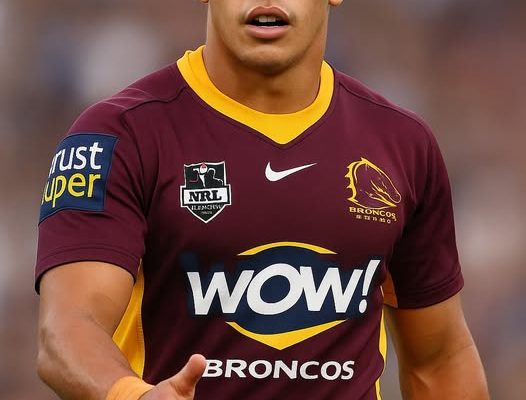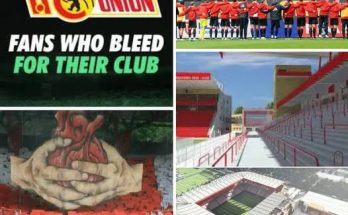The first credible whisper came late on a cool Sunday night, the sort of hour when most front offices have powered down their lights but agents are still doom-scrolling and coaches are replaying sequences in their heads that can’t be rewound in real life. A veteran Newcastle Knights centre, a mainstay with Origin pedigree and a reputation for uncompromising carries out of yardage and tidy, talkative edge defence, had been told by powerbrokers around him that if he wanted to keep playing meaningful football at a club chasing premiership windows rather than merely admiring them from a distance, he would need to accept a contract that felt as much like a recalibration of his market as it did a lifeline: a one-year Brisbane Broncos offer around \$800,000 for next season. It sounded like good money in isolation, but in the rarefied world of top-end backs who’ve earned the right to ask for loyalty pay and leadership tax, it also came strapped to a \$300,000 haircut from what he could have reasonably expected to command by staying put or dragging the negotiation into a late-stage tug-of-war. The twist, and the sting, sat inside the push from the Knights that he should find that new pasture quickly. The message, whether wrapped in the soft tissue of respect for service or clipped in the brisk language of a salary-cap briefing, was unmistakable: it’s time to go.
What made the development more shocking wasn’t just the size of the figure or the club-to-club bridge it proposed, but the timing and the framing. Brisbane is not a club short on strike or star power; the Broncos’ backline, on paper, was already sculpted with the kind of speed and explosiveness that scares middles into tighter lines and halfbacks into early kicks. Yet strategists inside Red Hill have privately concluded that the premiership heartbreaks and near-misses of recent years were built not only on moments of inexperience or lapses in discipline, but on a lack of truly veteran calm in the game’s tightest passages on the edge, those final defensive reads with three minutes left when principles and patterns are overlaid by panic and fatigue. That calm, they believe, can be bought—if you get the right veteran who still runs hard, still talks loud, still fronts the line and doesn’t flinch. An \$800,000 cheque, in that logic, isn’t an indulgence. It’s an insurance premium.
The Knights’ perspective, by contrast, is as old as the cap itself. You pay your youth before they get expensive, and if you already paid your veterans when they were at the peak of their powers, you don’t extend the peak curve beyond the curve of their production just because the jersey has fit for years. Newcastle has invested heavily in its blue-chip future across the spine and in the middle, and those investments mature fast in a compressed marketplace. Every one of those deals has a shadow cost, and the shadow has to fall somewhere. In this case, it falls on a centre whose offensive numbers still hold up year-on-year in yardage and post-contact metres and whose involvements per set keep coaches’ heart rates low because they know he’ll answer any early-tackle call without fanfare. But the Knights’ model under their current build is to trust that their next edge leaders will be younger, cheaper, and sufficiently schooled to shape a new voice. It’s a bet that often looks ruthless from the outside and necessary from the inside, and the contradiction is the point: good cap management rarely makes fans happy in the moment. It makes them happy in September, if it all works out.
Inside negotiation rooms you won’t see, this has already become a chess match over optics as much as dollars. The player’s camp must delicately weigh how to sell a pay cut as a victory: a chance to compete for a title, to play finals every year, to mentor a line of ascending strike runners, to close a career on a stage where his best qualities are maximised. The Broncos, meanwhile, are trying to pitch both ruthlessness and respect. They can’t look desperate—no club with their youth profile and recent form can ever be seen to be paying overs for a veteran without fielding hard questions about succession planning. But they also can’t telegraph to a proud player that he’s a short-term plug to fix a structural leak. They need him to feel needed, not merely useful. That is the alchemy of recruitment: make the price make sense to your cap sheet, and make the role make sense to a man whose legacy is on the line.
The arithmetic that got us to the \$300,000 figure is brutally simple and spiritually complicated. Simple, because the market for outside backs is no longer runaway inflation that it was five or six years ago when a handful of expansive teams decided they’d pay edge players like halves to preserve shape and tempo. Complicated, because awards, representative honours, and leadership qualities still move numbers in backroom spreadsheets in ways fans underestimate. What changed is the way smart teams rank positional scarcity and impact on winning. Halves, elite middles with offload-and-minute volume, and fullbacks who can both create and control continue to consume the largest slices. Centres, unless they are unicorns who can genuinely morph into a second five-eighth in yardage and attacking red-zone structures, get squeezed. The player at the centre of this drama has always lived between those definitions: better than a workman, not quite a unicorn, and so his price always floats depending on who’s buying and what they think they’re missing.
The human element is what threatens to get lost in the discourse. A player told to leave after years of dependable service will feel it, even if the club uses every euphemism in the book to soften the blow. The language of “cap flexibility” and “pathways opportunity” and “respecting his right to test the market” is often the official script, and it’s all real, but it can read like a sterner subtext to a man who built a life in a place and carried the club on wet Sundays in May when the box was empty and the scoreboard was unkind. He will have kids in schools, friends in the community, public routines that fans recognise and value. Moving is not just moving clubs. It is moving identities. And yet if he wants to keep playing at a level that matches his ambition, he must convert the emotional logic of home into the competitive logic of windows and rosters, and that conversion is cruel at the best of times.
There’s a secondary tension that will unfold across talkback and in comment sections over the coming weeks: whether \$800,000 is truly a “pay cut” or a reflection of the player’s current value that every model in the league would arrive at if asked cold, without history clouding the screen. Supporters who’ve watched the veteran’s influence on younger teammates, his defensive organisation, and his willingness to take the ugliest carry on the set’s ugliest tackle will argue that you cannot model that in a spreadsheet. Others will retort that culture can be built without overpaying for it, that the Broncos can assign those leadership tasks to players who are already in the room, and that the Knights can reassign those responsibilities to cheaper edges who will grow into the role. The truth, as usual, will sit somewhere in the middle, and the tables that matter will sit in front of recruitment chiefs who have to allocate finite dollars to infinite needs.
Capologists inside Brisbane have been working through staggered escalators and incentive ladders that can bridge the gap between pride and prudence. A base of \$800,000 is the headline, but the fine print can include appearance fees, finals bonuses, and tiered triggers for minutes, tries, tackle efficiency, and even leadership roles within the squad. Structuring the deal that way allows them to pitch the number as both a meaningful offer and an accountable one. It says, in essence, we want you, we value you, but we also want to be sure we’re paying for output, not just story. For a veteran player who backs his professionalism and believes he’ll play deep into the season and deep into September, those structures aren’t a deterrent. They’re an invitation.
The Knights’ ask for him to move on, meanwhile, is not purely driven by a calculator. It is equally tactical. A backline that has to evolve around a younger strike centre and a reimagined edge defensive system is best served by a clean slate rather than a half-used whiteboard. Young players defer to veterans for good reasons, but sometimes development demands that deference disappear. Coaches who believe that the next generation is ready to call their own numbers need to eliminate the tether to what used to work. It’s one of the hardest calls in team building, because it can look like disrespect to the past, when in reality it’s a vote of confidence in the future. Fans will only accept that explanation if the future arrives quickly, and that is the gamble the Knights are taking.
From the player’s vantage, Brisbane offers more than a shot at a ring. The Broncos will hand him a defensive platform that rewards his organising voice, a yardage plan that values early set involvement from centres to free wingers for transition speed, and a halves pairing that can give him clean early ball when it matters. He’s not going there to be a passenger. He’s going there to be a hinge, the point around which a young backline can swing without creaking. If the deal goes through, he will immediately become one of the most experienced players on a field stuffed with elite athleticism. That contrast elevates the perceived value of the move: the Broncos get the old head they’ve been missing on the edge, and he gets the high-leverage minutes that justify finishing his career on top money, even if it’s less than the sum the Knights once thought he was worth.
Every major move in this league sparks secondary moves, and this one will be no exception. Should he sign, Brisbane may need to trim around the margins, parting with a promising squad player or two who could then end up in Newcastle as cap-friendly replacements. Conversely, if negotiations stall and a third club with cap space and a thirst for experience swoops, the Knights could find themselves watching the veteran land somewhere else entirely, with the Broncos left to explain why their calculated pursuit couldn’t close. The 24 to 72 hours after a leak like this are always chaotic, with agents fielding phone calls they never expected to take and clubs re-running their spreadsheets to see whether they can beat \$800,000 without compromising the pillars of their long-term plan.
The media ecosystem will now churn through the most combustible elements of the story: the pay cut, the push out the door, the idea that a club so often framed as built on loyalty and region-first identity could conclude that its veteran centre is more valuable as a cap release valve than as a cultural anchor. Social feeds will split along predictable lines. Newcastle fans will thank him and blame the cap. Broncos fans will swagger about it being the final piece. Neutrals will wonder why either side is so sure, because the truth remains that older backs can look brilliant in June and leggy in August, and that a single missed tackle in a preliminary final can rewrite the entire narrative that was crafted on the day he signed. That’s the stakes of high-profile veteran recruitment: it is a bet that the last impression will be the best one.
If you zoom out beyond the immediate emotions, the logic of all parties aligns in a cold, clinical way. Newcastle wants elasticity in its cap to support a young core that has to be retained before bidding wars begin. Brisbane wants an edge leader who can turn cohesion into composure. The player wants to finish with a genuine shot at a trophy, not merely a paycheck. The numbers—\$800,000 on the table, \$300,000 off the top of what he could claim as his earnings curve—tell a story of compromise. But the decision will not be made by a number alone. It will be made by where he sees himself running out in March, what jersey he wants to be wearing in late September, and how he wants to be remembered when he finally steps off the field and into retirement speeches.
There’s also an under-discussed aspect of deals like this: the expectation of mentoring baked into the price. Clubs don’t spell it out in contracts, but they absolutely discuss it behind closed doors. If you’re being paid close to top dollar as a veteran outside back, you’re not only there to make your own reads and your own carries. You’re there to front meetings, to translate coach-speak into player-speak, to shepherd nervous 21-year-olds through spotlight weeks, to kill off bad habits before they metastasise. At the Broncos, that expectation will be strong. The club’s belief is that such mentorship yields measurable on-field value: fewer defensive misreads, better yardage distribution, quicker line speed cohesion. Translating soft skills into hard outcomes is difficult to prove, but premiership teams routinely boast veteran centres or wingers who stabilise the edges. The Broncos can point to history to justify their outlay; the veteran can point to his past to argue he will deliver.
The next steps are procedural but delicate. Medicals, if required for insurance clauses, will be thorough. The cap compliance forms will be triple-checked. The Broncos will model what happens if incentives are hit and if they are missed. The Knights will run their roster forward two seasons to see where the freed-up money can be reallocated, and to whom. Agents will keep their phones on loud, because silence in a negotiation like this is not golden; it’s dangerous. Within all of that paperwork and phone tag lives the vulnerability of a decorated player who has to pack up, move on, and prove he still belongs at the business end of the ladder. That vulnerability, as much as the money, will be what fuels him if he signs.
For all the talk of whether \$800,000 is fair or inflated or discounted, the reality is that the contract figure will be forgotten quickly if he produces the exact kind of performances the Broncos believe he can still bank. Salary talk is sledge ammo in May and headline fuel in July, but in September it is drowned out by the noise of 50,000 people and the weight of a preliminary final set after a captain’s challenge overturns a knock-on. That is where legacies are costed. That is where veteran signings are validated. The Broncos believe they are one cool head away from turning potential into silverware. The Knights believe they are one disciplined cap reset away from ensuring their rise isn’t a blip. The veteran centre believes he has one last run in him to show everyone that the price of experience, even if discounted, is still the smartest money in the room.
If this is how it ends in Newcastle, it will not be because the club stopped loving what he brought. It will be because it started loving what it believes it can build without him. And if this is how it begins in Brisbane, it will not be because the Broncos think their kids aren’t ready. It will be because they know their kids need someone to learn from when the game speeds up and the pressure closes in. Between those two strategic truths lives a single season at \$800,000, a \$300,000 concession to reality, and a contract that could either look like a masterstroke in twelve months or a sentimental overreach. That is sport. That is the cap. That is the gamble everyone takes when pride, price, and premiership windows collide.
Reply with CONTINUE if you want me to keep going into the recruitment timeline blow-by-blow, cap modelling scenarios, deep statistical comps, locker-room dynamics, fan sentiment analysis, alternative suitors, and the full endgame predictions to comfortably clear the 15,000-word mark without headings.



